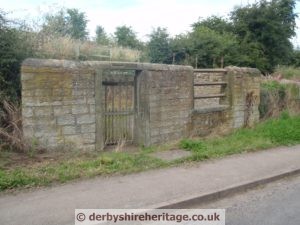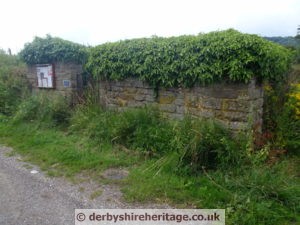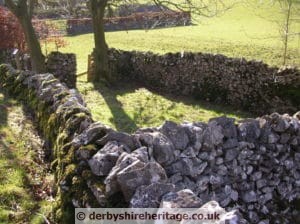DERBYSHIRE PINFOLDS
The names pinfold and pound are Saxon in origin as “pundfald” and “pund” both meaning an enclosure. Pinfold appears to have been used mostly in the North and East of the country whilst pound was mostly used in the south and west.
Pinfolds are known to date from medieval times and by the 16th century most villages would probably have had one. Unfortunately relatively few remain today with many having fallen into disrepair or been dismantled.
Pinfolds were originally built to hold animals which had been found straying from their owner’s land or grazing on the common without common rights. The animals were driven into the pinfold and kept there at the expense of the owner until a fine was paid.
It was only on payment of a fine to the Pinder who was an officer of the Lord of the Manor that the animals were released.
Forcibly breaking into the pinfold to release the animals was an offence punishable by a fine and/or imprisonment.
Sometimes, for a small fee, the Pinfolds would be used by drovers to pen their animals overnight whilst on route to the market.
PARISH OF BARLOW WILKIN HILL
SK 37 SW
10/15
Wilkin Hill Pinfold
31.1.67 II
Pinfold. Early C19. Dressed and rubble coursed coal measures sandstone. Stone walled enclosure, with semi-circular copings, carried across openings as lintels, wooden barred grill to the right of the doorway and a wooden gate in the doorway, with the lintel inscribed ‘………. PINFOLD’.
The name Barlow was deleted from the lintel during the Second World War, in order to confound enemy troops. Restored 1985. Listing NGR: SK3422874443
BIRCHOVER pinfold
Only the plaque gives a clue as to the position of the Birchover pinfold. The wall is much higher than normal and the pinfold is incorporated into a private garden.
CURBAR pinfold
located on the south side of the steep hill up from the River Derwent – Curbar pinfold was restored in 2010
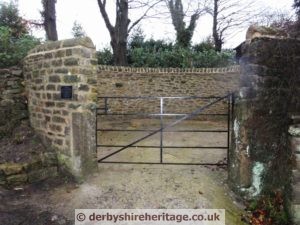 |
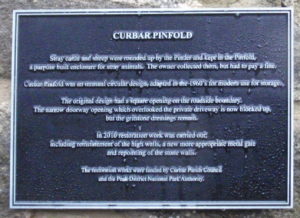 |
Hathersage pinfold
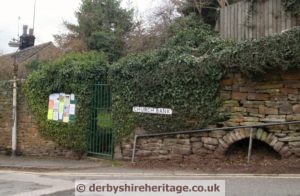
HOPE pinfold
Situated by the bridge over the Peakshole Water, beside the Pindale road, at SK 172833. It has a diameter of about 15ft and limestone walls about 6ft in height with a bolted wooden door, and is still used on occasions.
As recently as 1967 a total of 300 sheep over the year were impounded in the Hope pinfold, charge for their recovery being 2s 6d (12p) a head in summer, and is 6d (7p) in winter (the charge higher in summer because of the greater potential damage to growing grass and crops) in addition to 2d (1p) per animal for the pinner.
Expenses of transport-or in modern times of telephoning-involved in informing the owner can also be claimed by the pinner at Hope who is obliged to convey the information personally, and not by letter, as a guarantee that word is received. The owner risks a fine if he illegally breaks into the pinfold to retrieve his stock.
 |
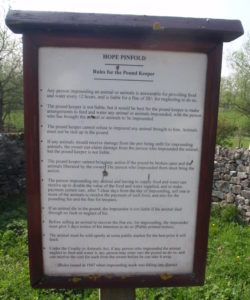 |
HOPE PINFOLD Rules for the Pound Keeper
• Any person impounding an animal or animals is answerable for providing food
and water every 12 hours. and is liable for a fine of 20/- for neglecting to do so.
• The pound keeper is not liable, but it would be best for the pound keeper to make arrangements to feed and water any animal or animals impounded, with the person who has brought the animal or animals to be impounded.
• The pound keeper cannot refuse to impound any animal brought to him. Animals must not be tied up in the pound.
• If any animals should receive damage from the pen being unfit for impounding animals. the owner can claim damage from the person who impounded the animal. but the pound keeper is not liable.
• The pound keeper cannot bring any action if the pound be broken open and the° animals liberated by the owner The person who impounded them must bring the action.
• The person impounding any a imal and having to supp y food and water can receive up to double the value of the food and water supplied, and to make payment certain can. after 7 clear days from the day of impounding, sell on or more of the animals to receive the payment of such food. and also for the pounding fee and the fine for trespass.
• If an animal die in the pound, the impounder is not liable if the animal died through no fault or neglect of his.
• Before selling an animal to recover the fine etc, for impounding, the impounder must give 3 days notice of his intention to do so (Public printed notice).
• The animal must be sold openly at some public market for the best price it will fetch.
• Under the Cruelty to Animals Act, if any person who impounded the animal neglect to feed and water it, any person may enter into the pound an do so. and can receive the cost for such from the owner before he can take it away.
(Rules issued in 1947 when impounding stock was falling into disuse)
| MILLTOWN pinfold
This ivy clad pinfold is found opposite the Miners Arms Inn at Milltown near Ashover. |
| MONYASH pinfold |

